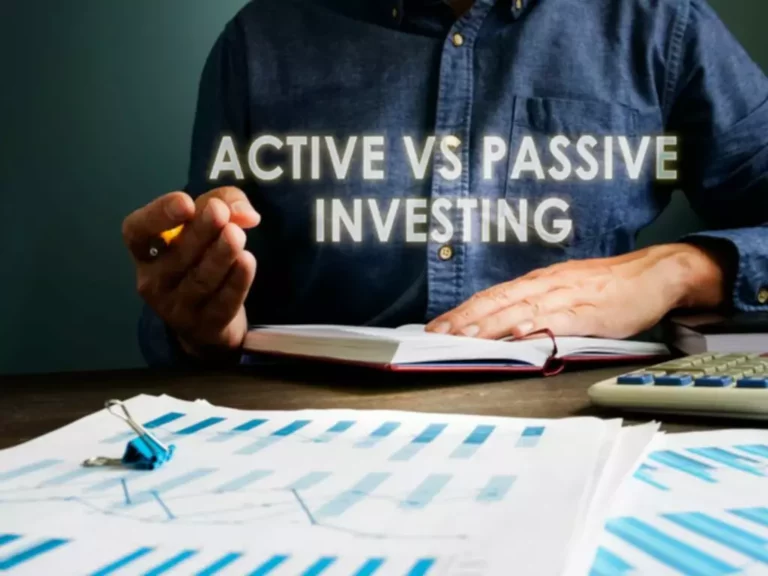
Energetic Vs Passive Investing: Choosing The Proper Path For Your Financial Journey
Both gauge their success towards widespread benchmarks like the S&P 500—but lively investing usually looks to beat the benchmark whereas passive investing aims to duplicate its efficiency. Your portfolio manager may know one of the best method of executing trades to find extra opportunities for tax loss harvesting and reduce your tax legal responsibility. Tax-loss harvesting is whenever you promote securities, like shares or ETFs, at a loss to offset capital gains elsewhere in your funding portfolio. While some robo-advisors provide this feature, human advisors have the expertise and incentive to find more tax-loss harvesting opportunities. You can select to be lively or passive when it comes to investing and monetary issues, too. You may manage your cash passively, for instance, by automating some transactions — similar to mechanically paying some payments and contributing to retirement accounts.
Your aim could be to match the performance of certain market indexes quite than trying to outperform them. Passive managers merely seek to personal all the shares in a given market index, in the proportion they are held in that index. Passive investing is when an investor buys belongings and holds onto them for an extended period. Passive investing usually means investing in index funds, which observe the efficiency of an index.
The appropriateness of a selected funding or strategy will depend upon an investor’s individual circumstances and aims. Morgan Stanley Wealth Management recommends that traders independently consider particular active trading vs passive investing investments and methods, and encourages traders to hunt the recommendation of a monetary advisor. Certain information contained herein may represent forward-looking statements.
Lively Investing Professionals And Cons
Active investing costs more, however an expert might be able to seize market opportunities that an indexing algorithm isn’t designed to perceive. Active and passive investing don’t need to be mutually unique methods, notes Dugan, and a mixture of the 2 might serve many traders. This is why energetic investing isn’t beneficial to most investors, particularly in phrases of their long-term retirement savings. Passive buyers purchase a basket of shares, and purchase more or less often, regardless of how the market is faring. This strategy requires a long-term mindset that disregards the market’s every day fluctuations. While this relieves you of the responsibility of choosing good investments, you won’t have the flexibility to jump on any trendy investment opportunities.
However, this method comes with risks—not all lively managers constantly outperform the market, and fees can erode returns. An example of a passively managed fund is an exchange-traded fund (ETF). In an ETF, the fund simply mirrors the actions of an index, set by entities like NSE or BSE, with buyers having no say in asset selection or removing. By investing in an index or benchmark, individuals commit to holding the investment for an extended interval with out trying to predict or react to market fluctuations. Due to the minimal shopping for and promoting of assets, passive investing is recognized as a cost-effective strategy.
How Can You Start Passive Investing?
The S&P 500 market represents 500 of the largest publicly traded firms within the United States. An S&P index fund, then, is an funding package deal particularly designed by a financial institution (typically a mutual fund or exchange-traded fund (ETF) provider) to replicate the performance of the larger S&P 500. Based on their experience and findings, the energetic investing administration staff will resolve which stocks to purchase or sell and when. The supervisor uses this similar approach frequently, often monitoring the portfolio and ensuring the combo continues to be fulfilling the fund’s purpose and assembly performance expectations. Passive investing and lively investing are two contrasting methods for placing your cash to work in markets.

Estimates of future performance are primarily based on assumptions that is probably not realized. Actual occasions could differ from these assumed and adjustments to any assumptions may have a fabric impression on any projections or estimates. Other events not taken into consideration may occur and should significantly affect the projections or estimates. Accordingly, there could be no assurance that estimated returns or projections shall be realized or that actual returns or performance results won’t materially differ from these estimated herein. «It’s necessary to note that research shows that individuals and fund managers do beat the market every so often. However, the overwhelming majority of traders do not persistently beat the market over long durations of time,» says Weiss. «In actuality, any edge they might create is commonly eradicated by the additional fees they cost, the trading prices they incur, and the upper taxes they create.»
Lively Vs Passive Investing: Key Differences
Passive funds permit a specific index to information which securities are traded, which suggests there is not the added expense of analysis analysts. Active investing is a method where an investor attempts to beat the market by buying and selling individual shares, bonds, or other securities. You’d suppose a professional cash manager’s capabilities would trump a basic index fund.

New and extra casual buyers typically take the route of the passive investor who focuses on steadily building wealth over the lengthy term with lower charges and less threat. More advanced and experienced traders, on the other hand, could prefer an energetic investing method that capitalizes on short-term fluctuations in the market for the possibility to hit the jackpot. Perhaps the most important advantage of an active investing approach is having a human investor on your https://www.xcritical.com/ side. Active fund managers are usually surrounded by teams of monetary experts and analysts who spend their days conducting in-depth analysis to pick the best stocks and identify lucrative opportunities. When these fund managers are proper in their selections, you can hit it big. Active vs. passive investing is an ongoing debate for a lot of traders who can see the benefits and drawbacks of each methods.
But you might also face a studying curve as you determine what kind of investing suits you and whether that fashion suits your objectives. They are used for illustrative purposes only and don’t characterize the performance of any specific funding. International investing entails larger danger, in addition to higher potential rewards compared to U.S. investing. These risks embrace political and financial uncertainties of overseas nations as well as the risk of currency fluctuations.
Investors with both energetic and passive holdings can use active portfolios to hedge in opposition to downswings in a passively managed portfolio throughout a bull market. Investors in passive funds are paying for pc and software to move cash, rather than a high-priced skilled. So passive funds usually have decrease expense ratios, or the annual value to personal a bit of the fund. Those decrease costs are another factor within the higher returns for passive buyers. Portfolio managers don’t have to comply with specific index funds or pre-set portfolios. Instead, active fund managers can decide and choose investments as they see fit and reply to real-time market conditions to have the ability to beat short-term market benchmarks.
For most individuals, there’s a time and a spot for active and passive investing over a lifetime of saving for major milestones like retirement. More advisors wind up combining the two strategies—despite the grief each side gives the opposite over their technique. Only a small share of actively managed mutual funds do higher than passive index funds. Active mutual fund managers, both within the United States and abroad, consistently underperform their benchmark index. For instance, sesearch from S&P Global found that over the 20-year interval ended 2022, only about 4.1% of professionally managed portfolios in the united states consistently outperformed their benchmarks.
- An energetic fund supervisor’s experience can translate into larger returns, but passive investing, even by novice traders, consistently beats all but the top players.
- If they buy and maintain, traders will earn near the market’s long-term average return — about 10% annually — meaning they’ll beat almost all skilled traders with little effort and lower price.
- Our estimates are primarily based on past market performance, and previous efficiency just isn’t a assure of future efficiency.
- Before becoming a member of Forbes Advisor, John was a senior author at Acorns and editor at market research group Corporate Insight.
- Investors with both energetic and passive holdings can use energetic portfolios to hedge against downswings in a passively managed portfolio during a bull market.
Active fund managers assess a wide range of information about every investment in their portfolios, from quantitative and qualitative information about securities to broader market and economic developments. Using that information, managers purchase and sell belongings to capitalize on short-term worth fluctuations and hold the fund’s asset allocation on track. While some passive investors like to pick funds themselves, many select automated robo-advisors to build and handle their portfolios. These online advisors usually use low-cost ETFs to keep bills down, and they make investing as straightforward as transferring money to your robo-advisor account. Passive investing strategies typically perform better than active methods and value much less.
The introduction of index funds in the Nineteen Seventies made achieving returns according to the market much easier. In the Nineteen Nineties, exchange-traded funds, or ETFs, that observe main indices, such because the SPDR S&P 500 ETF (SPY), simplified the process even additional by permitting traders to commerce index funds as if they had been shares. Passive ETFs track indexes such because the S&P 500 and will make sense for traders pursuing a buy and maintain strategy. Active ETFs depend on portfolio managers to choose out and allocate assets in an effort to attempt to outperform the market. The securities/instruments discussed in this materials is in all probability not appropriate for all investors.

A passive strategy utilizing an S&P index fund does higher on average than an energetic approach. Similarly, mutual funds and exchange-traded funds can take an lively or passive approach. NerdWallet, Inc. is an impartial writer and comparison service, not an investment advisor. Its articles, interactive instruments and other content material are supplied to you at no cost, as self-help instruments and for informational purposes solely. NerdWallet does not and cannot guarantee the accuracy or applicability of any information in regard to your particular person circumstances.

The fund is handled by a professional portfolio manager who analyzes and selects which particular person shares might be included in the fund. The portfolio supervisor and their staff conduct intensive research on varied companies, weighing factors like enterprise financial health, progress prospects, competitive place and trade developments. Passive investing is shopping for and holding investments with minimal portfolio turnover. Active investing is buying and selling investments based mostly on their short-term performance, attempting to beat common market returns.
Generally talking, the objective of lively managers is to “beat the market,” or outperform sure commonplace benchmarks. For example, if you’re an active US equity investor, your aim could additionally be to realize higher returns than the S&P 500 or Russell 3000. Active investing revolves round hands-on administration, aiming to maximise returns. The objective here is to be hands-on, with merchants using various techniques to time their entries and exits available within the market.
